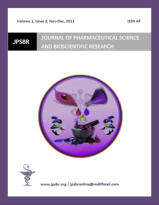





Development and Validation of First Order Derivative Spectrophotometric Method for Simultaneous Estimation
of Theophylline and Bambuterol in Bulk and Synthetic Mixture
Dharmesh G. Zanzarukiya, Dr. Jignesh S. Shah





Regulatory Requirements for Marketing Authorization of Generic Parentral Product in European Conutries by
Decentralised Procedure
Pratik Makvana*, Dr. Dilip Maheshwari




Volume 4, Issue 2
Pages no. 138-183

Comparative Study of Good Manufacturing Practice (GMPs) Requirements for Sterile Pharmaceutical Products
in USA and INDIA
Vishal Prajapati*, Dr. Jignesh Shah, Dr. Dilip Maheshwari





Comparison of Regulatory Framework for Registration of Medical Device in CANADA and MALAYSIA
Brijesh D. Upadhyay*, Dr.Dilip Maheshwari





A Comprehensive Study on Comparison of Registration Process of Vaccine in INDIA and USA
Aanal Shah, Mr. Darshil Shah Dr. Dilip Maheshwari





Absorption Correction Method for Simultaneous Estimation of Phenazopyridine HCl and Ciprofloxacin HCl in
Combined Tablet Dosage Form
Parth P. Sonara, Dr. Jignesh S. Shah





Comparative Study of Regulatory Requirements for Post-Approval Changes in US, EUROPE & SOUTH AFRICA
Rahulgiri Goswami, Dr. Dilip Maheshwari







© JPSBR Publications 2011-2024
Powered by Opus
ABSTRACT:
A simple, precise, accurate and reproducible Spectrophotometric method has been developed for Simultaneous
Estimation of Theophylline and Bambuterol by employing first order derivative method in methanol and water.
The first order derivative absorption at 273 nm (zero cross point of Theophylline) was used for quantification of
Bambuterol and 264 nm (zero cross point of Bambuterol) for quantification of Theophylline. The linearity was
established over the concentration range of 20-180μg/ml for Theophyllineand 10-50μg/ml for Bambuterol with
correlation coefficient R
2
0.999 and 0.998, respectively. The mean % recoveries were found to be in the range of
99.49 – 100.70 % and 98.91 – 100.37 % for Theophylline and Bambuterol, respectively. The proposed method has
been validated as per ICH guideline and successfully applied to the simultaneous estimation of Theophylline and
Bambuterol in their Synthetic Mixture.
Keywords:
Theophylline, Bambuterol, First order derivative, Synthetic mixture, Method validation.

ABSTRACT:
There are three procedures by which a marketing authorisation in EU can be obtained, Centralised Procedure
which is compulsory for any novel medicinal products, subject to agreement by Committee on Proprietary
Medicinal Products (CPMP), Mutual Recognition Procedure (MRP) which commences only after a marketing
authorisation has been issued in a EU member state, which then becomes the Reference Member State (RMS) and
the Decentralised Procedure which is applicable in cases where an authorisation does not yet exist in any of the EU
Member States. This review article attempts to an insight on the recent regulatory aspects and marketing
authorisation procedures in Europe by giving a detailed overview of the decentralised procedure along with the
proper timelines to aid various pharmaceutical applicants to make proper marketing applications and place their
products in the European Markets. Decentralised procedure came into operation in late 2005. Identical dossiers
are submitted in all MS where a marketing authorization is sought. A RMS, selected by the applicant, will prepare
draft assessment documents and send them to the CMS. They, in turn, will either approve the assessment or the
application will continue into arbitration procedures. Decentralised Procedure involves CMS at an earlier stage of
the evaluation than under the MRP in an effort to minimize disagreements and to facilitate the application for
marketing authorisation in as many markets as possible.
KEY WORDS:
Centralised, Mutual Recognition, Decentralised Procedure, common technical document

ABSTRACT:
The objective of this work helps in bringing the awareness about the manufacturing requirements as per USFDA
and India. The present study deals with a brief overview of the GMP requirements for sterile pharmaceutical
product manufacture as per USA and India. Parenteral products are intended to be non-pyrogenic too, additionally
to the requirement to be sterile. Medicinal drug products that do not meet the requirement to be sterile, non-
pyrogenic can otherwise cause severe harm to life, threatening health risk to patient. It is necessary to know the
differences in the requirements of guidelines given by USFDA and India. Knowledge of the differences in the
requirements is important to guarantee the quality products and their supply in due time for the designated
market. These guidelines focus on the parameters to be stressed on while manufacturing sterile pharmaceutical
product and when these guidelines were compared, certain similarities and differences were observed.
Key Words:
Indian GMP, Schedule M, US cGMP, USFDA

ABSTRACT:
The knowledge and compliance with regulatory requirements is a key to success in development and marketing of
medical devices. As the use of medical devices has increased, stringent regulatory standards are required to
ensure safety, efficacy and performance of medical devices with least adverse effects. Recently introduced
guidelines help to provide adequate guidance for effective registration by competent authorities, manufacturers
and importers. The Malaysian medical devices regulatory framework is based on the global harmonization trends
as promoted by “the Global Harmonization Task Force (GHTF)” and Canada follows well developed and specific
guidelines “Medical Devices Regulations (SOR/98-282)”. The present article overviews the detailed regulation
framework for registration of medical devices in Canada and Malaysia.
Keywords:
Global Harmonisation Task force
(
GHTF), Common Submission Dossier Template, Quality management
systems, Filing of medical device licence application, Regulation of medical devices.

ABSTRACT:
Present study was focused on comparison of registration process of Vaccine in INDIA and USA. Vaccination is one
of the most cost-effective health interventions available, saving millions of people from illness, disability and death
each year. The vaccine industry is highly regulated. Vaccine development is a complex and time-consuming
process. Before a new vaccine is approved for release into the market, a stringent regulatory procedure to assess
quality, efficacy and safety must be undertaken. The regulation of vaccines in India with respect to the licensing
and GMPs is controlled by the Drug Controller General of India (DCGI) and Central and State Drugs Control
departments like Central Drugs Standard Control Organization (CDSCO) and Drug Regulatory Authorities (DRAs).
Meanwhile, in USA the regulation of vaccines is controlled by USFDA in which Center for Biologics Evaluation and
Research committee (CBER) and Biologics License Application (BLA) authorities are responsible for vaccine
regulation. Comparison of registration process of vaccine in concern countries determine which country is more
reliable based on time consumption, money, complex-lengthy process etc.
KEY WORDS:
Immunization Schedule, Vaccine registration process, Comparison of regulatory requirements for
vaccine registration, DCGI (Drug Controller General of India), CBER (Center for Biologics Evaluation and Research),
USFDA (United States Food and Drug Administration), CDSCO (Central Drugs Standard Control Organization)

ABSTRACT:
A new, simple, precise, accurate and sensitive UV ‐ Spectrophotometric absorption correction method has been
developed for simultaneous determination of Phenazopyridine HCl and Ciprofloxacin HClin combined tablet
dosage form. Methanol was used as solvent. Absorbance correction method was based on the property of
additivity of absorbances. The two wavelengths on Phenazopyridine HClcurve were found out, which were 279 and
413 nm. At 413 nm, Phenazopyridine HClshowed some absorbance while Ciprofloxacin HClshowed zero
absorbance. Both the drugs gave absorbance at 279 nm. The method involved solving of an equation based on
measurement of absorbance at two wavelengths 279 and 413 nm. The determinations were made at 279 nm for
Phenazopyridine HCl and Ciprofloxacin HCl and 413 nm for Phenazopyridine HClover the concentration range of 2-
10 μg/ml for Phenazopyridine HCl and 2.5-12.5 μg/ml for Ciprofloxacin HClwith mean recovery of 99.56% and
100.63% for Phenazopyridine HCl and Ciprofloxacin HCl, respectively by absorbance correction method. This
method was found to be simple, sensitive, accurate, precise, reproducible and economical and can be applicable
for the simultaneous determination of Phenazopyridine HCl and Ciprofloxacin HClin combined dosage form.
KEYWORDS:
Phenazopyridine HCl, Ciprofloxacin HCl, Absorbance correction method, Validation, Combined dosage form

ABSTRACT:
Chemistry, Manufacturing and Controls (CMC) changes are inevitable due to many reasons including changing
needs, new findings and continuous improvement. Therefore, regulations require that all changes be evaluated
carefully and follow the proper regulatory path for implementation, regardless of whether it is an investigational
or a commercial product. Failure to comply with regulatory requirements for post- approval CMC changes can
potentially lead to “misbranded or adulterated” status for a given product. This should be taken very seriously for
marketed products because of the potential safety/efficacy impact for the vast number of patients as well as legal,
regulatory and business impact for the sponsor. In light of QbD paradigm, leveraging the product and process
knowledge gained and the use of a risk based approach should allow a sponsor to achieve the best path for post-
approval change implementation. So This guidance provides recommendations to sponsors of new drug
applications (NDA's), abbreviated new drug applications (ANDA's), and abbreviated antibiotic applications (AADA's)
who intend, during the postapproval period, to change in US, EU, SOUTH AFRICA.
Key words: USFDA, EMA, MCC, Post approval changes, Regulatory Authorities







































































































